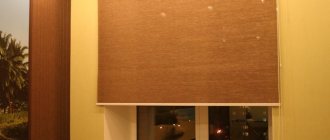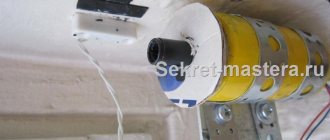A sign of modern housing is large windows. Sometimes a lot of light gets in the way and doesn’t allow you to relax. Every owner is thinking about installing blinds on the plastic windows of their home.
Of course, blinds play a big role for comfortable living. Depending on the intensity of sunlight in rooms facing south and east, they can be either completely closed or only partially covered. And the purpose of the room itself also plays a significant role. For example, it is better to choose transparent structures for the dining room, but for the bedroom you need ones that can completely prevent the penetration of sunlight into the room.
Blinds play a big role for comfortable living
But in addition to the above function, these structures also protect against noise that can come from the street.
In addition, blinds are an excellent window decoration. Even stripes look stylish and strict and do not require much maintenance.
Of course, it is best to install them yourself. But every owner is faced with the problem of choosing: which blinds are suitable for his room, what to choose - vertical or horizontal. After all, home comfort and coziness depend on the correctness of the decision made.
In a modern apartment, blinds are commonplace
In a modern apartment, blinds are a common thing. These original curtain substitutes have long been part of our lives. They give the space a certain aesthetics, elegance, and beauty. Their skillful use allows you to emphasize advantages and hide disadvantages.
Designs and installation methods
There are two types of blinds for windows - vertical and horizontal. Vertical slats are usually made of plastic or special dense fabric, cut into strips 10-15 cm wide. Less commonly, you can find slats made of aluminum or synthetic threads.
Vertical blinds can be used not only for windows, but also for plastic doors with full glazing
The slats of horizontal blinds come in plastic, wood and metal. Regardless of the type and material, they consist of a cornice and slats. Cornice is a plastic or aluminum U-shaped profile in which the controls are located and from which the lamellas are suspended. Lamels are horizontal or vertical stripes/plates that actually cover the opening. In order to be able to open and close the blinds, there are controls - chains or threads.
The design of horizontal blinds includes a large number of threads
In horizontal models there is also a control rod connected to a rotating mechanism. By rotating the rod, the angle of inclination of the lamellas is changed. This is how you can change the amount of light and the “degree of transparency” of the window. If the slats are placed vertically (almost), they completely block the view. When positioned horizontally, they hardly interfere with the view, but there are many other positions.
Installation of horizontal and vertical blinds
When installing blinds, you need to attach the cornice. To fix it, the kit includes specially designed brackets. These brackets are attached to the window or wall, and the cornice is simply put on them (until it clicks).
There are several ways to install blinds on sash windows:
- Directly on each window sash. This installation method will allow you to use the window sill at any time. The only limitation is that you cannot place objects close to the frame. Many people are afraid of the need to make holes in the PVC profile with this installation method. The presence of several additional holes in the plastic does not affect the properties of the window. In addition, blinds can be attached to an opening window sash without drilling .
- Secure it in the opening so that only the window is covered, but not the adjacent walls. With this installation method, the cornice is attached to the upper slope.
- Attach to the ceiling. In this case, there should be enough space to open the sash (at least 5 cm).
- On the wall. Attach the curtain rod directly to the wall above the window.
- Install on additional long brackets. This option is suitable for shallow window openings, when blinds hanging close to the wall do not allow the sash to be opened.
How to install blinds on plastic windows: installation methods
You will have to decide on the method of installing the blinds before purchasing: the size of the canvas depends on this. So the type of installation must be chosen before taking measurements.
Required Tools
To install blinds on plastic windows with your own hands, you will need a number of tools:
- drill;
- screwdriver (can be replaced with a regular screwdriver);
- drills and attachments for screwing in screws;
- dowels;
- screws;
- roulette;
- hacksaw or scissors (for adjusting sizes);
- hammer drill (if the structure is hung on a running wall);
- simple pencil.
When installing with tape, you only need double-sided tape, a tape measure, a simple pencil, and a degreaser.
We take measurements
You need to decide on the type of blinds (horizontal, vertical) and the method of installing them (on a wall, on a ceiling, in a sash window, in a window opening) before purchasing. And even before you start measuring. Because different installation methods require different sizes. Only with correct measurements will it be easy to install blinds on plastic windows.
For everything to work well, you need to take the measurements correctly.
Another important point: you need to measure each window separately . Sometimes it just seems like they are absolutely the same. Believe me, there is a difference. You also need to write down the measurement results and sign which specific window you measured and which sash it is. Accurate and detailed records will help avoid confusion during purchase and installation.
In the window opening
Although the appearance of the products is different, when measuring there is no difference between horizontal and vertical models. If you are going to install blinds in a window opening, you need to subtract 2 cm from its width on each side. You can subtract 1-3 cm from the height of the opening. Such gaps are needed so that the canvas hangs freely in the opening and the lower edge of the slats does not rub against the window sill.
How to measure when installing in a window opening
Please note that you can install blinds on plastic windows “in the opening” not flush with the edge of the opening, but deeper - near the glass itself or by stepping back 5 or more centimeters from the edge. If the opening has a trapezoidal shape, the height/width of the opening will be smaller for the glass, so we take careful measurements. And also, in this case, it is better to put marks for installation when measuring. Then you will know exactly where you will need to install blinds on plastic windows so that their dimensions fit perfectly.
On the ceiling or wall
Here the measurements depend on your desires. The length of the blinds can be up to the floor or just up to the window sill. Moreover, depending on the type of installation chosen, the slats can cover the window sill or not. So the length is whatever you like.
This is wall mounting. When mounted on the ceiling, the length will increase, but how much is up to you
The width of the blinds with this installation method is wider than the window opening. How much wider depends on your desire, but the minimum offset is 5 cm on each side. But if the window is in the same plane as the wall surface, you will need additional brackets, which are not included in the package: the slats must be placed at a distance of at least 5 cm from the glass surface so that they do not interfere with opening the doors for ventilation.
On the doors
When installing blinds on a multi-leaf window, there are two options - install one device on each sash or order one long one for the entire window. Usually the first option is chosen - it makes it possible to open and close the shutters with the blinds lowered. If you choose this installation method, you will need to measure each sash and record the results. The doors may be different, so be careful.
The option on the right is more convenient
The width of the blinds when installed on the shutters is taken to be 3 cm wider than the glass. When hanging, the lamellas overlap the profile by 1.5 cm. This is convenient and does not interfere with opening/closing windows. The length depends on the location of the fastener, but usually it is 5 cm longer than the height of the glass.
Once again we draw your attention: we measure each sash!
Useful tips from the master
To ensure that the installation of blinds on plastic windows is successful and the entire structure looks neat, you should listen to the advice of the experts. They are presented in the list:
- Self-cut blinds look less neat. Therefore, it is important to take correct measurements before purchasing.
- When purchasing blinds, you should check the package contents.
- To ensure that your blinds last a long time, you should not clean them too often. It is enough to wipe off the dust once a week with a dry soft cloth. Otherwise, everything will wear out quickly.
- If you have pets that damage the slats, you should give preference to inter-frame blinds.
Tell us about your experience installing blinds in the comments. Save the article to bookmarks or repost it on social networks.
How to install blinds on plastic windows: attach to a wall or window opening
The first step is to apply markings. We install brackets in the cornice. We place them on the right and left so that they do not interfere with the operation of the blinds. The installation height depends on the selected product length.
We attach the curtains, mark with a pencil on the wall the places for installing fasteners in the brackets. If we are installing horizontal blinds (they are light and create almost no load), it is enough to install one screw/dowel. Vertical ones are heavier, so you need to install all the fasteners from the kit.
Installing blinds on the ceiling and walls is the same. Only the mounting location of the bracket changes
There is a second way. At the selected level, use a building level to draw a horizontal line, try to avoid tilting - this will affect the blinds (skew). Place the bottom of the bracket against this line and use a pencil to mark the holes for drilling. If the length of the cornice is more than 2 m, an additional bracket is required to increase the rigidity of the structure, which is attached in the middle.
This is what vertical blinds look like installed in a window opening
When attaching to brick or concrete, drill holes in the wall or ceiling at the marked points. A drill or a hammer drill - whoever has what is available. The diameter of the drill depends on the size of the dowels. They usually come included, but you can supply your own.
We insert spacer dowels into the finished holes and carefully hammer them in with a hammer. We install the brackets, fasten them with screws or nails (if dowel-nails are used). We install the cornice on the brackets and insert the plugs on the sides. For horizontal blinds, attach a rod (handle) to control the swing mechanism. To do this, install a special hook (included) directly into the mechanism itself, and attach the tip of the rod to this hook.
Types of installation
There are four types of blind installation:
- To the opening
- In the doorway
- To the ceiling
- On the sash
Not every type of blind allows you to choose from all four options. This is due to the technical features and functionality of different designs. But you shouldn’t assume that the best blinds are those that can be installed in any of the four available ways. Perhaps your best option involves only one type of installation, but it will be the ideal choice for your room.
Installation of horizontal blinds on PVC window sashes
With this installation method, the blinds are attached with small self-tapping screws (included in the kit) to the window profile. They must be installed so that they do not interfere with the handle turning. Be careful: if you drill too close to the bead, you can damage the glass unit. Therefore, in this case, correct measurements are very important.
Installation of blinds on a PVC window
Installation step by step
The procedure is as follows:
- We install the fasteners on the cornice so that they do not interfere with the moving parts inside.
- Let's try the product on the frame. We set it so that the slats overlap the drain frame and the right at the same distance.
- Mark with a pencil or marker the place where the fasteners should be located. During this operation, you need to keep the cornice as level as possible. You can follow the contours of the window frame or use a level.
- Although the plastic is quite soft and you can immediately screw self-tapping screws into it to prevent the frame from cracking, it is better to pre-drill the holes. The diameter of the drill is slightly smaller than the diameter of the screws. Usually the kit comes with self-tapping screws with a diameter of 3 mm, so you need to take a 2 mm or 2.5 mm drill.
- We take the brackets and fasten them to the frame with self-tapping screws.
We screw in the screws - Insert the blind rod, pressing until it clicks.
- We close the ends with the plugs that come with the kit.
Having to drill holes in a window frame can be intimidating, but it's no big deal. In case of incorrectly made holes, the unsuccessful ones can be filled with sealant. White silicone, not acrylic (acrylic quickly turns yellow). The performance of the windows will not be affected. What can be dangerous is getting into a double glazed window. Then it may crack. But this is not fatal either - it can be replaced, although it will not be cheap.
We install the lower clamps
But that is not all. To finally install horizontal blinds on plastic windows, you need to drill a couple more holes - for the clamps (also called anti-wind). These are additional fastenings at the bottom of the opening window sash. The lower edge of the blinds is tucked into them. They do this so that when ventilating, the blinds do not hang down, dangle in the wind, or knock over objects on the windowsill.
Don't hang out...
We install the clamps like this: we try them on, pulling the blinds down a little, mark the fastening points, drill holes, and install them. We tuck the bottom bar into the installed clamps. Now, even with a draft or an open shutter, the blinds will not dangle. The only thing you need to watch out for during installation is not to get caught in the glazing bead (this is a long strip that runs along the glass unit and holds it in place). It is necessary to drill a hole in the frame itself, stepping back at least 1 cm from the edge. Otherwise there are no problems.
No drilling
There is also a way to install blinds on plastic windows without drilling the frame. This method is only available for those blinds that are hung on opening sashes. In this case, they are simply hung on plastic mounts/brackets, which are placed on the frame from above. To prevent them from moving, a strip of double-sided tape is attached to the back of the bracket. After removing the protective film, you can glue it (but you don’t have to fix it).
The shape of the plastic fasteners depends on the type of cornice. So you need to select it specifically for each
These L-shaped plastic brackets are not included, but can be purchased at a store or company that sells horizontal blinds. This method is convenient by simply dismantling the blinds, which is convenient if they need to be repaired or washed.
Assembly of vertical blinds
Vertical blinds are installed exactly as described above. The difference is that the slats are installed after the cornice (the guide along which the runners move) has been secured. For convenience, before attaching the slats, you can use an adjustment cord to turn the sliders so that the slots in them are perpendicular to the cornice. Next, we simply snap the slats into the runners, inserting the strip until it clicks. So, we fasten all the slats one by one.
Fastening plastic vertical slats
If the slats are made of fabric, then after installing them do not forget to insert the lower weight. Next, we attach the lower connecting chain to the lamellas.
How to assemble vertical blinds
The installation of vertical blinds is complete.
What material are they made from?
In addition to the functionality of the design and its type, when choosing blinds you need to pay attention to the material from which they are made.
Modern blinds are made from:
- Plastic. Such models are light in weight and easy to care for, but the slats quickly fail (they bend, deform and break). After their installation, the room takes on a strict office look. To make it cozy, you have to use additional decorative elements.
- Metal. Aluminum plates are stronger and last longer, but they are more expensive. The slats do not fade in the sun and are not afraid of temperature changes. When opening, they make an unpleasant noise; it also occurs when there is a draft, when the plates rub against the glass.
- Tree. Such models look beautiful, but the cost of wooden structures is the highest. Nowadays, bamboo slats are very popular: they are durable, practical and fit well into any interior design. The large weight of the plates causes the structure to stretch over time and they sag.
- Fabrics. Fabric slats are treated with special compounds, so dust does not accumulate on them, they do not absorb odors, and do not fade in the sun. Caring for the product involves periodic cleaning with a brush; if necessary, the plates can be removed and washed.
- Fiberglass. The material has a high degree of fire safety, so these blinds are well suited for the kitchen. The slats can only be cleaned dry. If they are heavily soiled, they should be dry cleaned.











